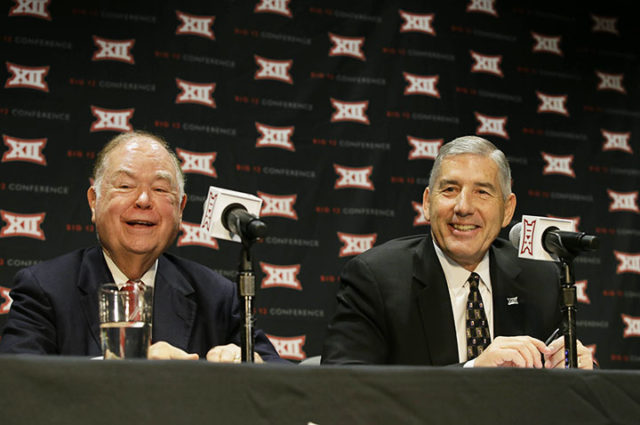By Meghan Mitchell | Sports Editor
After two days of deliberation, the Big 12 Board of Directors unanimously decided Monday not to expand its conference and to remain with the current 10 universities.
“We had a very thoughtful and candid meeting which showed a great deal of strength in the conference,” said Dr. David L. Boren, president of the University of Oklahoma and chair of the Big 12 Board of Directors, in a press conference Monday. “We have a strong commitment from every single member of the board to the cohesiveness and stability of the conference.”
According to Boren, the Big 12 plans to continue to look for ways to enhance the league through new technologies and resources. The idea of expansion is not an active agenda item at the moment, but it could come back up in the future.
“Ten presidents came together in unity and came to the same conclusion,” Big 12 Commissioner Bob Bowlsby said. “We like the competition model we have with the full round robin. We do a very good job in competing at the highest level, and this decision in part was a celebration. It was an endorsement and reinvestment in the strength of the 10 we have.”
Due to the decision, the Big 12 remains as the only conference to set its own rules and will continue to determine its champions directly on the field of play with a full round-robin schedule as each team has a chance to play against each other.
Although expansion is not occurring, the Big 12 announced on June 3 that the Big 12’s football championship game would be reinstated at the end of the 2017 regular season.
“The decision was unanimous; all the schools participated very actively in the decision,” Boren said. “Once we decided the issue would no longer stay on the agenda, we moved on.”
According to ESPN writer Brett McMurphy, Bowlsby had planned to video conference with 20 different universities that hoped to be added to the Big 12 Conference. However, Bowlsby cut that list down to 11 in July after being given permission to look further into the expansion.
The 11 candidates that the the decision closed down on were the United States Air Force Academy, Brigham Young University, University of Central Florida, University of Cincinnati, Colorado State University, University of Connecticut, University of Houston, Rice University, Southern Methodist University, University of South Florida and Tulane University. According to Bowlsby, the league at that time was interested in adding two or four new members to the conference and delivering a conference television network to the conference. However, with no network in place, hopes for expansion diminished.
“The marketplace made that decision for us,” Boren said. “I hoped we could find a way when we thought we could build a conference network. We needed additional material, additional schools to have additional material for the network. To do that then, I think, would have made sense. The situation now is very, very different. We don’t feel a sense of urgency to expand just for expansion’s sake. It has to be tied to the circumstances at the time.”
West Virginia in 2012 will remain the last new member added to the Big 12, as none of the current candidates were the chosen to expand for the Big 12.
“The decision really didn’t have very much to do with the individual elements of those institutions,” Bowlsby said. “They all have their strengths and weaknesses, obviously, as all of our members do. But this was really about defense of our model.”


